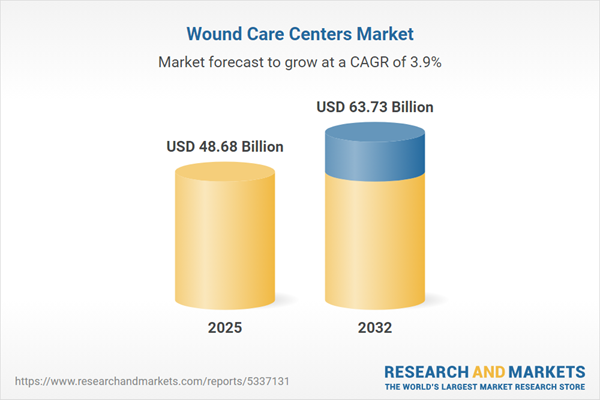Speak directly to the analyst to clarify any post sales queries you may have.
The wound care centers market is experiencing significant transformation, shaped by continuous advancements in care delivery, regulatory frameworks, and evolving patient needs. Innovative technologies and new clinical protocols are driving progress, offering healthcare leaders meaningful opportunities to optimize patient care, streamline operations, and enhance long-term value.
Market Snapshot: Wound Care Centers Market
The wound care centers market grew from USD 46.84 billion in 2024 to USD 48.68 billion in 2025. It is expected to continue growing at a CAGR of 3.92%, reaching USD 63.73 billion by 2032. This growth underscores the market's expanding role in healthcare ecosystems, driven by rising chronic disease burdens and increasing demand for specialized care settings that address complex wound management across multiple patient populations.
Scope & Segmentation
This report delivers comprehensive analysis and forecasts across principal market segments and regions, reflecting the diverse drivers and dynamics within the wound care space. Segmentation is structured as follows:
- Product Types: Devices (including electrical stimulation, hyperbaric oxygen therapy, negative pressure wound therapy, and ultrasound therapy), Dressings (encompassing alginate, composite, film, foam, hydrocolloid, and hydrogel types), and Wound Care Services.
- Applications: Includes burns, diabetic foot ulcers, pressure ulcers, surgical wounds, and venous leg ulcers.
- End Users: Encompasses ambulatory surgical centers, home healthcare settings, hospitals, and specialty clinics.
- Distribution Channels: Covers direct sales, ecommerce platforms, hospital pharmacies, and retail pharmacies.
- Treatment Types: Distinguishes advanced methods (bioengineered skin substitutes, cellular therapy, growth factor therapy, tissue engineered products) from traditional approaches (bandages, gauze).
- Regional Coverage: Includes Americas (with region-specific detail for North America and Latin America), Europe, Middle East & Africa, and Asia-Pacific, reflecting nuanced regional market influences.
- Company Coverage: Recent and emerging trends are analyzed for leading providers, including Smith & Nephew plc, 3M Company, Mölnlycke Health Care AB, ConvaTec Group plc, Coloplast A/S, Medline Industries, Integra LifeSciences, B. Braun Melsungen AG, Cardinal Health, and Derma Sciences.
Key Takeaways
- Advanced wound care centers are becoming integral within holistic healthcare delivery, due to rising prevalence of chronic conditions and shorter inpatient durations.
- Significant clinical innovation—including electrical stimulation devices, digital monitoring platforms, and bioactive dressing materials—is enhancing patient outcomes and supporting personalized treatment strategies.
- Telehealth and remote monitoring have empowered care teams to provide timely assessment and intervention, improving patient compliance and optimizing resource utilization.
- Market segmentation demonstrates diverse adoption drivers, with differentiation based on care setting, technology use, and application focus, requiring tailored strategies for engagement across end users and channels.
- Regional factors—such as reimbursement provisions, regulatory standards, and health infrastructure—shape local market dynamics, signaling the need for adaptive strategies aligned to unique market needs.
Tariff Impact and Strategic Response
United States tariffs imposed in 2025 have contributed to increased costs for imported wound care products and devices. Providers and suppliers are responding by prioritizing domestic sourcing, intensifying supplier negotiations, and pursuing financial strategies to manage input cost volatility. These tariff measures also reinforce the importance of local innovation and supply chain flexibility in sustaining market growth.
Methodology & Data Sources
The research draws upon a dual-method approach, combining extensive secondary analysis with primary interviews among industry leaders and key stakeholders. Quantitative modeling incorporates data triangulation from proprietary and public sources. Quality control protocols and localized expert validation ensure reliability and relevance of all market insights.
The Wound Care Centers Market: Why This Report Matters
- Enables senior leaders to benchmark innovation adoption, segment performance, and market positioning across global, regional, and segment-specific levels.
- Supports the formulation of resilient supply, procurement, and partnership strategies for navigating regulatory changes and tariff implications.
- Delivers actionable intelligence to drive value-based care initiatives, inform R&D priorities, and enhance patient-centered outcomes in diverse healthcare settings.
Conclusion
The wound care centers market is undergoing rapid evolution, fueled by clinical innovation, segmentation depth, and shifting policy landscapes. Senior decision-makers are empowered to leverage these insights for sustained growth, operational agility, and strengthened market leadership in wound care delivery.
Additional Product Information:
- Purchase of this report includes 1 year online access with quarterly updates.
- This report can be updated on request. Please contact our Customer Experience team using the Ask a Question widget on our website.
Table of Contents
3. Executive Summary
4. Market Overview
7. Cumulative Impact of Artificial Intelligence 2025
Companies Mentioned
The companies profiled in this Wound Care Centers market report include:- Smith & Nephew plc
- 3M Company
- Mölnlycke Health Care AB
- ConvaTec Group plc
- Coloplast A/S
- Medline Industries, L.P.
- Integra LifeSciences Holdings Corporation
- B. Braun Melsungen AG
- Cardinal Health, Inc.
- Derma Sciences, Inc.
Table Information
| Report Attribute | Details |
|---|---|
| No. of Pages | 194 |
| Published | October 2025 |
| Forecast Period | 2025 - 2032 |
| Estimated Market Value ( USD | $ 48.68 Billion |
| Forecasted Market Value ( USD | $ 63.73 Billion |
| Compound Annual Growth Rate | 3.9% |
| Regions Covered | Global |
| No. of Companies Mentioned | 11 |









